engine BUICK SKYLARK 1993 User Guide
[x] Cancel search | Manufacturer: BUICK, Model Year: 1993, Model line: SKYLARK, Model: BUICK SKYLARK 1993Pages: 306, PDF Size: 15.84 MB
Page 80 of 306

2 (Second Gear)
This position gives you more power but lower fuel
economy. You can use
“2” on hills. It can help
control your speed as you go down steep mountain
’
roads, but then you would also want to use your
brakes
off and on.
1 (First Gear)
This position gives you even more power (but lower
fuel economy) than
“2.” You can use it on very steep
hills, or in deep snow or mud.
If the selector, lever is
put in
“1,” the transaxle won’t shift into first gear
until the vehicle
is going slowly enough. ,
Don’t drive in “2” (Second Gear) for more than 5
miles (8 km), or at speeds over 55 mph (88 km/h),
or you can damag ansaxl
much as possible.
Don’t shift into “2” unless you are going
slower
than 65 mph (105 km/h), or you can damage your
engine.
79
Page 82 of 306
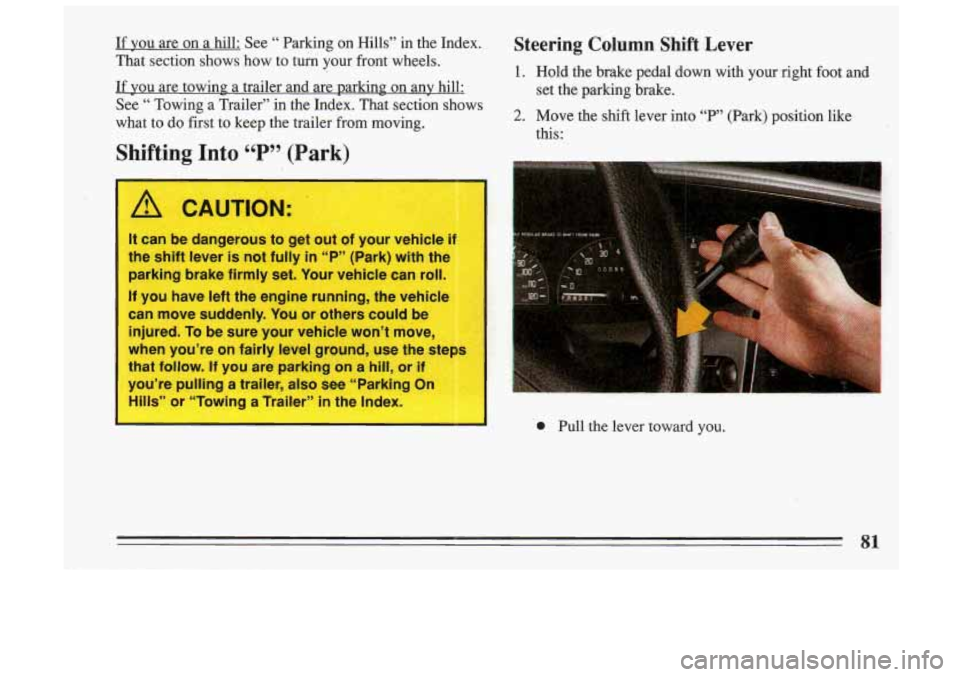
If YOU are on a hill: See “ Parking on Hills” in the Index.
That section shows how to tuk your front wheels.
If you are towing a trailer and are parking on any hill:
See
“ Towing a Trailer” in the Index. That section shows
what to do first to keep the trailer from moving.
Shifting Into 44 P 99 (Park)
I I
A CAUTION:
It can be dangerous to get out of your vehicle if
the shift lever is not fully in “PYy (Park) with the
parking brake firmly set. Your vehicle can roll.
If you have left the engine running, the vehicle
can move suddenly. You or others could be
injured. To be sure your vehicle won’t move,
when you’re on fairly level ground, use the steps
that follow.
If you are parking on a hill, or if
you’re pulling a trailer, also see “Parking On
Hills” or “Towing a Trailer”
in the Index.
Steering Column Shift Lever
1. Hold the brake pedal down with your right fuot and
2. Move the shift lever into “F”’ (Park) position like
set
the parking brake.
this:
0 Pull the lever toward you.
81
Page 84 of 306
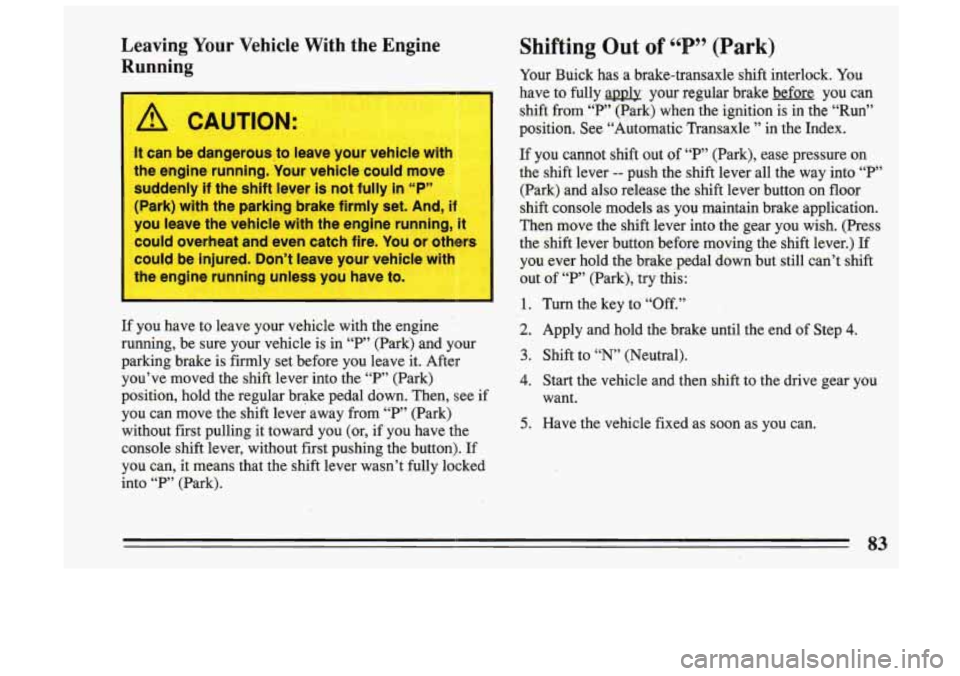
Leaving Your Vehicle With the Engine
Running
CAUTION:
It can be dangerous,to leave your vehicle with
the engine running. Your vehicle could move
suddenly
if the shift lever is not fully in “P”
(Park) with the parking brake firmly set. And,
il
you leave the vehicle with the engine running, it
could overheat and even catch fire. You or others
I
could be injured. Don’t leave your vehic ’ wi
the engine running unless you have to.
I
If you have to leave your vehicle with the engine
running, be sure your vehicle is in
“P” (Park) and your
parking brake is firmly set before you leave it. After
you’ve moved the shift lever into the
“P” (Park)
position, hold the regular brake pedal down. Then, see if
you can move the shift lever away from “P” (Park)
without first pulling it toward you (or, if you have the
console shift lever, without first pushing the button). If
you can, it means that the shift lever wasn’t fully locked
into
“P” (Park).
Shifting Out of P (Park) 66 99
Your Buick has a brake-transaxle shift interlock. You
have to fully applv your regular brake before
you can
shift
from “P” (Park) when the ignition is in the “Run”
position. See “Automatic Transaxle ” in the Index.
If you cannot shift out of “P” (Park), ease pressure on
the shift lever -- push the shift lever all^ the way into “P”
(Park) and also release the shift lever button on floor
shift console models as you maintain brake application.
Then move the shift lever into the gear you wish. (Press
the shift lever button before moving the
shift lever.) If
you ever hold the brake pedal down but still can’t shift
out of “P” (Park), try this:
1. Turn the key to “Off.”
2. Apply and hold the brake until the end of Step 4.
3. Shift to “N’ (Neutral).
4. Start the vehicle and then shift to the drive gear you
5. Have the vehicle fixed as soon as you can. want.
Page 85 of 306

Parking Over Things That Burn
A CAUTION:
Things that can burn could touch hot exhaust
rrts under your vehicle and ignite. Don’t park
over papers, leaves, dry grass or other things
3t can burn.
/1 CAUTION:
Engine exhaust can kill. It contains the gas
carbon monoxide
(CO), which you can’t see or
smell.
It can cause unconsciousness and death.
You might have exhaust coming
in if:
Your exhaust system sounds strange or
Your vehicle gets rusty underneath.
Your vehicle was damaged in a collision.
Your vehicle was damaged when driving
over hinh Doints on the road or over road
different.
debris.
0 Repairs weren’t done
correctly.
I Your vehicle or exha tern had been
modified improperly.
If you ever suspect exhaust is coming into your
I vehicle:
Drive it only with all the windows down to
blow out any
CO; and
Have it fixed immediately.
I
Page 86 of 306
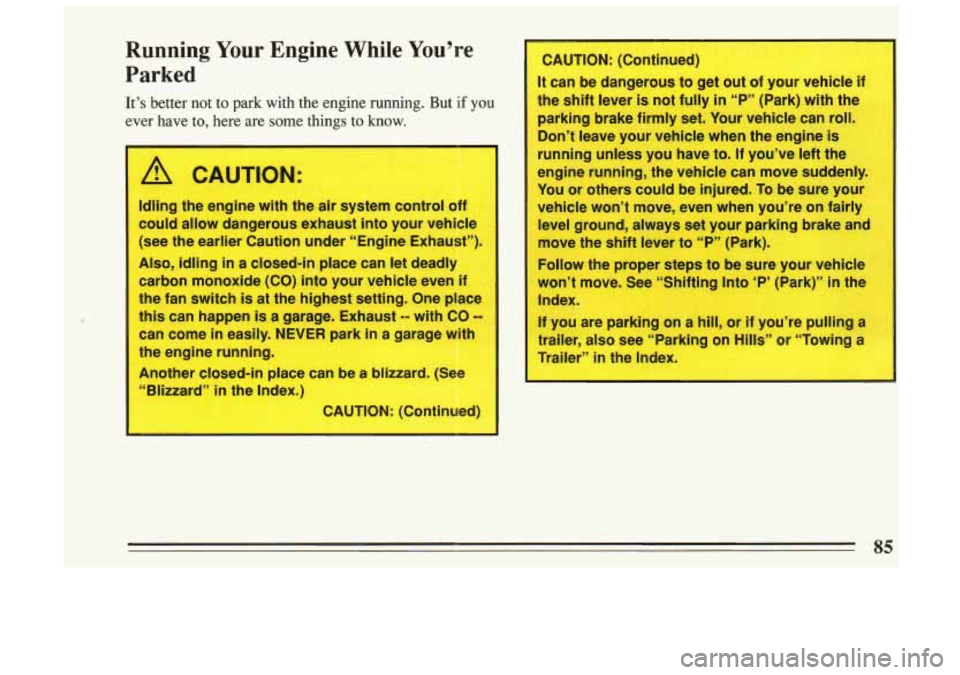
P
-Running Your Engine While You’re
‘Parked
It’s better n.ot to park with the engine running. But if YOU
ever have to, here are~same things to how.
Idling the engine with tfie air 31 em control off
8could al~low dangerous exhaust into jour vehilcle
(see the earlier Cawtionunder “‘Engine IExhaust”:
Also, idling In a Closed-in> place can let‘ ‘dead.,
‘carbon monoxide
(CO) into yo~ur ve,hicle ewn if
t’he fan switch
is at the highest setting. One placl
this can happen is agarage. Exhaust -- with CO
can came in easily. #NEVER park in a garage with
the engine running.
Another clq3ed8-in;
place can be a blizzard. l(See
in the Index.)
nued:
It can ‘be dangerous ta get ‘olut lof ,your vehicle if
‘the shift lever is not fully
in T’ (Park) witlh trhe
parking brake flirmly set. Your vehicle
can roll.
Dm’t leave yaur vehic;le when the engine
is
running unless you have to. If you’ve lefi the
enlgine running, the vehicle can
move suddenly.
You
or others cou!ld be injured. To be sure yow’r
vehicle wonlpt move, even when
you’re on fair ~
level gramd, always set your parking brake and’
move
the shift lever to “P” (Park).
Follow the prope!r steps
to be sure your vehicle
wm’t move. See “S’hifting
Into ‘PB (Park)”’ in the
Inde?.
If
you are parking on a hill, or if you’lre pulling a
trailer,
atso see “Parking OM Hills”’ or “Towing, a
‘Trailer”
in th’e Index.
85
Page 110 of 306
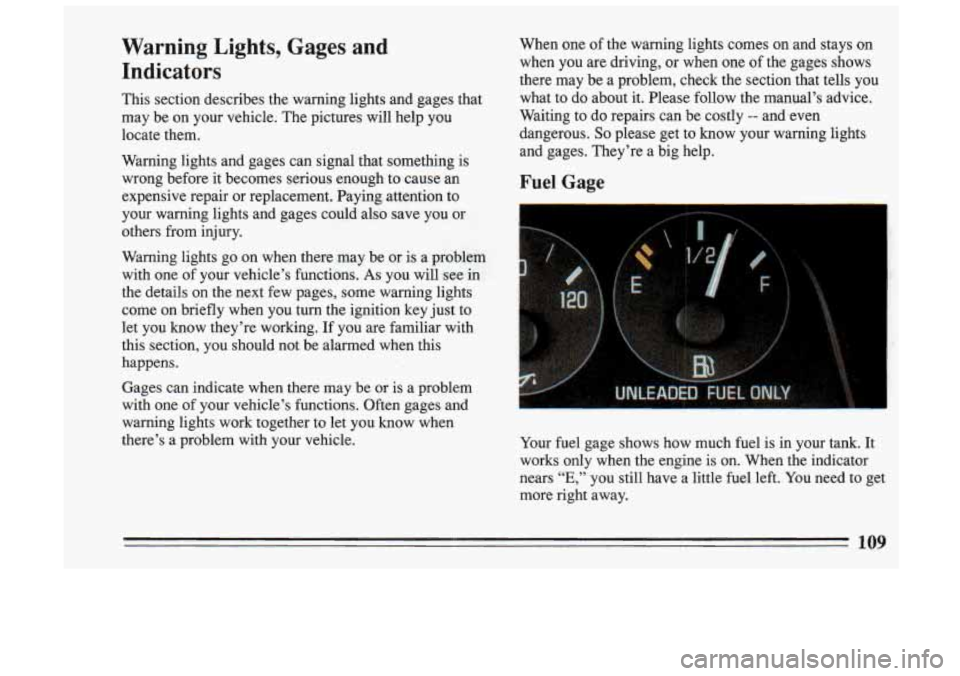
Warning Lights, Gages and
Indicators
This section describes the warning lights and gages that
may be on your vehicle. The pictures will help you
locate them.
Warning lights and gages can signal that something is wrong before it becomes serious enough to cause an
expensive repair or replacement. Paying attention to
your warning lights and gages could also save you or
others from injury.
Warning lights go on when there may be or is a problem with one of your vehicle’s functions.
As you will see in
the details
on the next few pages, some warning lights
come on briefly when you turn the ignition key just to
let you know they’re working. If you are familiar with
this section, you should not be alarmed when this
happens.
Gages can indicate when there may be or is a problem
with one of your vehicle’s functions. Often gages and
warning lights work together to let you know when
there’s a problem with your vehicle. When
one
of the warning lights comes on and stays on
when you are driving, or when one of the gages shows
there may be a problem, check the section that tells you what to do about it. Please follow the manual’s advice.
Waiting to do repairs can be costly
-- and,even
dangerous.
So please get to know your warning lights
and gages. They’re a big help.
Fuel Gage
Your fuel gage shows how much fuel is in your tank. It
works only when the engine is on. When the indicator
nears
“E,” you still have a little fuel left. You need to get
more right away.
Page 112 of 306
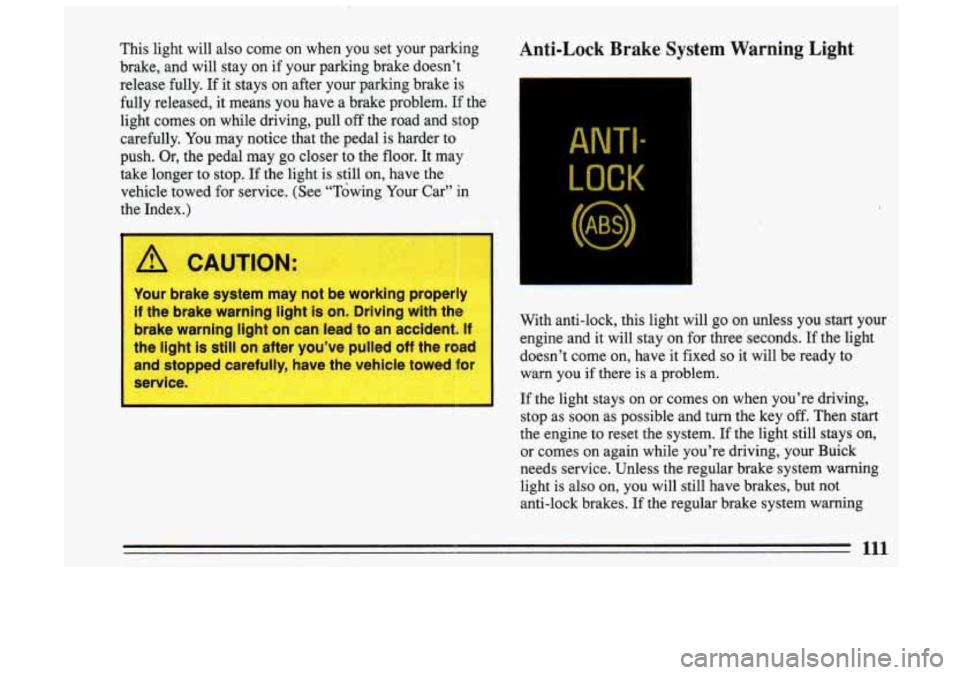
This light will also come on when you set your parking
brake, and will stay on
if your parking brake doesn’t
release fully. If it stays on after your parking brake is
fully released, it means you have a brake problem.
If the
light comes on while driving, pull
off the road and stop
carefully, You may notice that the pedal is harder to
push. Or, the pedal may go closer to the floor. It may
take longer to stop. If the light is still on, have the
vehicle towed for service. (See “Towing Your
Car” in
the Index.)
-
1
I A CAUTION:
Your brake system may not be working properly
if the brake warning light is on. Driving with the
brake warning light on can lead to an accident. If
the light is still on after you’ve pulled off the road
and stopped carefl
r, have the vehicle towed for
service.
I
Anti-Lock Brake System Warning Light
ANTI.-
LOCK
With anti-lock, this light will go on unless you start your
engine and it will stay on for three .seconds. If the light
doesn’t come on, have it fixed
so it will be ready to
warn
you if there is a problem.
If the light stays on or comes on when you’re driving,
stop as soon
as possible and turn the key off. Then start
the engine to reset the system. If the light still stays on,
or comes on again while you’re driving, your Buick
needs service. Unless the regular brake system warning
light is also on, you will still have brakes, but not
anti-lock brakes. If the regular brake system warning
111
Page 114 of 306
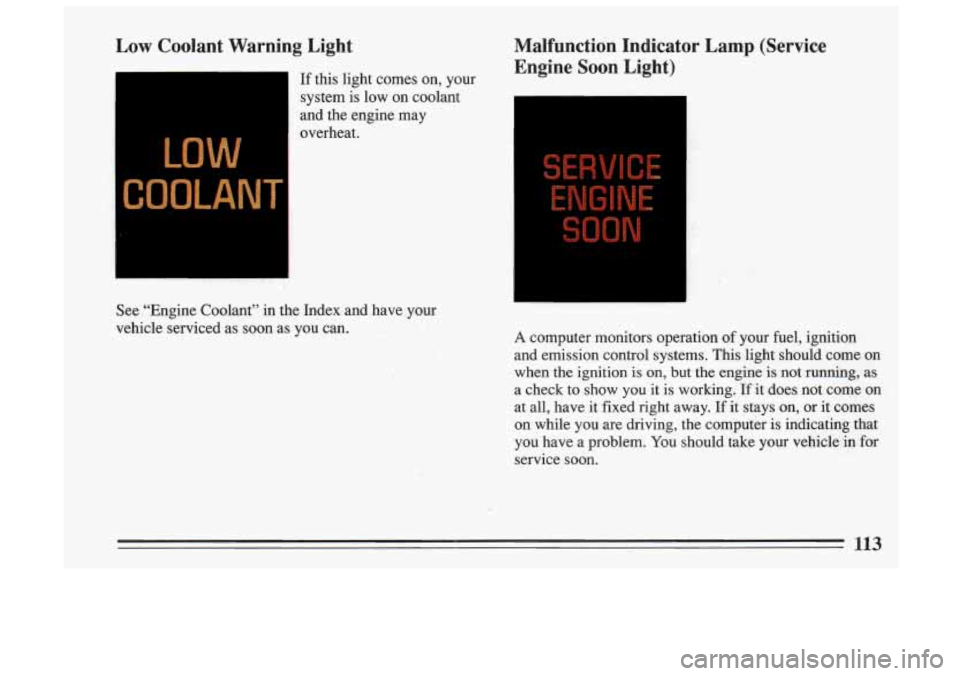
Low Coolant Warning Light
If this light comes on, your
system is low on coolant
and the engine may
overheat.
Malfunction Indicator Lamp (Service Engine Soon Light)
See “Engine Coolant’’ in the Index and have your
vehicle serviced as
soon as you can. A computer monitors operation of your fuel, ignition
and emission control systems. This light should come on when the ignition is on,
but the engine is not running, as
a check
to show you it is working. If it does not come on
at all, have it fixed right away. If
it stays on, or it comes
on while you are driving, the computkr is indicating that
you have a problem. You should take your vehicle in for
service soon.
Page 116 of 306

This gage tells you if there could be a problem with your
engine oil pressure.
If the gage reads in the red band, and stays there, it
means oil isn’t going through your engine properly. You
could be low on oil or you might have some other oil
problem.
Don’t keep driving if the oil pressure is low. If
you do, your engine can become so hot that it
catches fire. You or others could be burned.
Check your oil as soon as possible and hp-
I your vehicle serviced.
“Check Oil” Light
e
The “Check Oil” light is lit
for three seconds as a bulb
check each time the
ignition key
is turned to the
RUN position. If the light
doesn’t come on, have your vehicle serviced.
If ‘the engine oil is more than one quart low, the light
will come on briefly, then
go off for 15 - 25 seconds,
and then come back on for
20 - 40 seconds.
However, under the following conditions, the system
will not register a low engine oil condition.
0 If the vehicle is tilted more than 20°. I problems can be costly and is not covered by
If it has not been more than 8 minutes since the
engine was last shut off.
115
Page 117 of 306
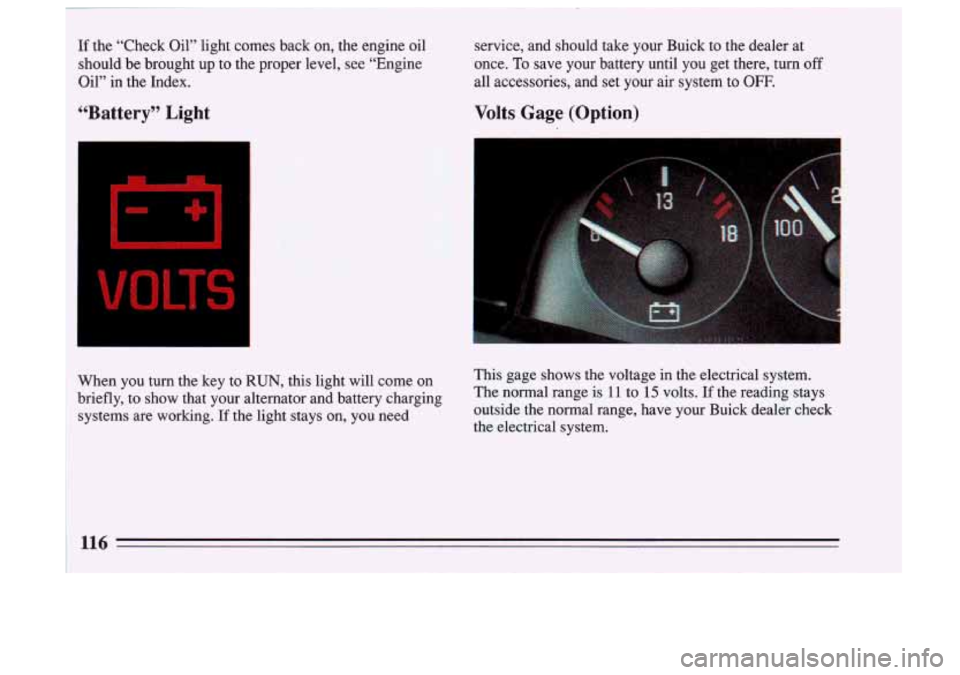
If the “Check Oil” light comes back on, the engine oil
should be brought up to the proper level, see “Engine
j Oil” in the Index.
“Battery” Light
When you turn the key to RUN, this light will come on
briefly, to show that your alternator and battery charging
systems are working.
If the light stays on, you need service, and should take your Buick to the dealer
at
once. To save your battery until
you get there, turn off
all accessories, and set your air system to OFF.
Volts Gage (Option)
This gage shows the voltage in the electrical system.
The normal range is
11 to 15 volts. If the reading stays
outside the normal range, have your Buick dealer check
the electrical system.